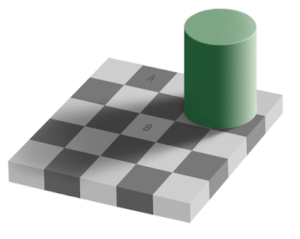We like to think that our senses lead us in the right direction, enabling us to make optimal choices based on our perceptions of reality.
However, often our senses, particularly when faced with complex situations, can distort reality and lead us to make incorrect inferences and false conclusions.
Illusions provide good examples of this. Take a look at this checkerboard illusion below and see if you can tell which square is darker, Square A or Square B?

Spoiler Alert: Square A and Square B are the same colour and shade!
Here is a link to a clever YouTube video which proves the illusion. Whilst here is another a link to an explanation from the clever guys at MIT
All is Not What It Seems.
My work as a performance coach in financial market involves me undertaking deep conversations with investors and traders about their processes.
I am also helped in this by my studies in Gestalt Psychology, which deals with perception and helps explore beneath the surface, and over 20 years’ working as a trader.
One thing that continues to surprise me, is the many creative ways different traders and investors use to help navigate a path through the minefield of financial markets. Just when I believe that a particular method or approach doesn’t work, someone will come along and prove me wrong.
However, it is when I go deeper into exploring their approach, that I then find all is not what it seems on the surface. Often the method they espouse is not as much the root of their success as they think it is.
Some years ago I coached a very successful private trader who had decided he would teach his method to other traders whom he could then fund and take a cut of their profits. A kind of mini turtles programme.
He took on several trainees and spent considerable time teaching them his method and approach. However, with one exception, none of these trainees were able to make his method or approach work. Even the one exception did not truly follow his method, instead he applied his own unique style.
The trader was puzzled as to why these individuals could not replicate what he was doing. After we investigated his approach and method, he started to realise that the approach he was using, based almost entirely on price action, was not really his edge. At the point of action, he was adding his own twists based on his intuition.
The analysis of price action was important, it took him to the point of action. But it was not the deciding factor which made him take or exit a trade.
Suddenly it dawned on him that he had been teaching these individuals a technique which had no edge. The edge he did have was unique to him and was intuitive and largely unconscious.
The Best Guess and Mental Models.
The trader mentioned above’s model was effectively a ‘mental model’. At the point of action it relied on an educated guess. He was not takening every single signal, sometimes he was taking it when it happened, other times, dependent on his reading of the situation and ocntext, he would hold off for a bit. Human judgement was involved, and this made it incredibly difficult to replicate, let alone explain.
It is an uncomfortable reality for many, but trading, and even investment, rely to a high degree on ‘guessing’. Even systematic processes require human judgement somewhere in the construction process, and again in the management and maintanance process.
For those uncomfortable with the idea of being engaged in guessing activities, the term ‘Bayesian Inference’ may prove more comforting.
Bayesian Inference is a term which encompasses the ‘educated guess’, rather than random guessing process.
All models help improve the guessing process by reducing noise and providing a way to navigate complexity. n the above example the traders method and approach added up to his model. Other models may be more open to description, such as quantitative models and systematic approaches.
I wrote an article some years ago on Keynes the investor. In it I described how it was not Keynes’s vast knowledge of economics which ultimately proved to be the deciding factor in his success as an investor, but a model he applied which he described as akin to a ‘Beauty Contest’ approach to stock picking.
This approach (model), which an early forerunner of ‘value investing’. It embraced, as does Warren Buffeet and Charlie Munger, to a high degree the idea of ‘educated guessing’.
Analysis informs, but it is rarely enough on its own. Success in the financial markets relies on models in some form.
Cultivating High Performance in Financial Markets:
At Alpha R Cubed, we are passionate about Cultivating High Performance In Financial Markets.
We work with Traders and Investors, Leaders and Teams, and whole Organisational Systems from across the spectrum of Financial Market Businesses.
If you are curious about any aspect of our work and would like to enquire about how we could help you or your business, then please email us at info@alpharcubed.com.



